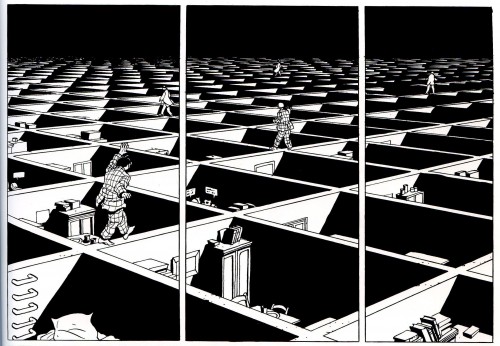

Q: Many countries have ministries of culture. Does America need a Secretary of Culture or Secretary of the Arts? Why or why not?(This is a revised version of a submission for Carnegie's Spring For Music Blogger Contest.)
While the government arts funding question is perhaps well-trodden ground, the question of whether America needs a cabinet-level Arts/Culture Secretary is one that comes up less often, but one that deserves careful consideration. Would this position provide the arts with the support, political clout, and visibility needed in order to thrive? Is a Secretary of Arts/Culture part of the solution to the arts problems in America? To begin the discussion, let me start by asking a question as a prompt:
Name the three most important and/or popular contributions to the arts from Canada in the last 50 years that first come to mind.
Why Canada? Whenever I've discussed arts and government funding, the prevailing opinion in the arts community is that Europe and our neighbor to the north are the enlightened ones who we should be emulating, and, as a former Canadian (I became a naturalized US citizen in 2007), I know the Canadian system well.
Before we get to the responses, let's look at the Canadian system. In Canada, they have a cabinet level Minister of Canadian Heritage whose department creates policies and provides funding for "arts, culture, media, communications networks, official languages, status of women, sports, and multiculturalism." (Well, I am very pleased to see that the poor, beleaguered, long-suffering sports community is finally getting some attention and hopefully some funding from the government-how else would hockey, baseball, and football survive otherwise?). The current Deputy Minister is Daniel Jean. His background for this position? He holds an MBA from SUNY-Buffalo and has a BA in Political Science and Economics from the University of Ottawa. Additionally, he "has a vast experience in government...was consul and Immigration Program Manager in Haiti during the coup that ousted elected President Jean-Bertrand Aristide." Coup in Haiti? Cool! Tinker, Tailor, Soldier . . . Arts Minister!
 Daniel Jean, Deputy Minister
Daniel Jean, Deputy Minister
Here's a list of what is funded and here's the Department's organizational structure. If that's not enough, here's a link to a pdf which contains a chart of their organizational hierarchy. (Read all three links for the full stultifying effect.)
What I've listed so far does not include the many additional programs available at the provincial level. Ontario, for example, has its own Ministry of Tourism, Culture and Sport. The current minister is Michael Chan. His background for this position? He "owned and operated a successful insurance brokerage firm."
 Michael Chan, Minister of Tourism, Culture and Sport
Michael Chan, Minister of Tourism, Culture and Sport
There is also the Canada Council for the Arts which provides grants for visual arts, media arts, dance, music, theatre, and writing and publishing. It is similar to the National Endowment for the Arts that we have here in the USA. There are also many other organizations, like the Canadian Music Centre (CMC) with its main office in Toronto and four regional offices. The CMC works to " ...stimulate[s] the awareness, appreciation and performance of Canadian new music..." [Full disclosure: I'm an "Associate Composer of the Canadian Music Centre" but my dues have lapsed and, according to their content laws, I'm not sure if I qualify as "Canadian" anymore...]
But that's not all that Canada has to offer in the promotion of arts and culture. Through the Canadian Radio-television and Telecommunications Commission (CRTC), Canada maintains strong "Canadian content" laws that require radio and television stations, as a condition of licensing, to program a certain amount of programming that is purely and truly Canadian. Currently, that amount is 40% for radio and a whopping 60% for television. (For a description of whose work qualifies as "Canadian" in this bureaucratic boondoggle, click here.)
Let's revisit the prompt from the beginning when I asked you to name three arts contributions from Canada. Here are my best guesses as to the Top Ten responses:
- Glenn Gould
- Canadian Brass
- Oscar Peterson
- Rush
- Bryan Adams
- Margaret Atwood
- Robertson Davies
- Jim Carrey
- Dan Aykroyd
- Deadmau5
While I'm sure that some of these artists probably benefited from some government funding at some point in their careers, does anyone seriously believe that they would have languished in obscurity without the Ministry of Culture? To phrase this another way, with all of the funding and programs that Canada offers, why isn't it the world's leader in the arts?
I know it might lead to vertigo or mild nausea, but look once more at the mind-numbing size and complexity of the Canadian system in those links above. Imagine how much that costs in salaries, buildings, offices, supplies, conferences, travel, and the other expenses to feed the beast. In addition to the significant potential for distasteful political interference and pandering, scarce resources are being diverted from the actual artists to the administrators who are, unlike the artists who get funded once or twice a decade, drawing a good middle- or upper-class salary every year.
Now, consider this fact: Canada's population is currently about 34 million, which means it is smaller than California. Can you imagine what this Secretary of Culture, Tourism, Sports, and Kayaking would look like in a country the size of the United States?
I'm sure that the people who founded these supportive agencies never dreamed that they would morph into these leviathans awash with redundancies and layer upon layer of bureaucratic oversight, but they do. It's in the nature of these types of organizations to grow; in the Darwinian mosh pit of resource allocation in the attenuated government funding realm, you grow or you die (or you're perceived as dying, which is close to same thing).
This is a sobering example of what happens when government gets seriously involved in the arts business the way it has in Canada. The bureaucracy soon becomes a Kafka-esque entanglement of countless programs run by swarms of sinecure political appointees who may have no background in the arts, and yet hold the power to anoint certain works and to reject others. If you think the evaluation system would be politically neutral, think again. Artists are forced to "market" their work to these mid-level policy wonks using the bland, passive, politically correct language of the bureaucrat. That process eventually becomes a prime motivator in the development of the artwork itself. The snake now feeds on its own tail as the formerly independent artist marches to the tune of the bureaucrat/administrator du jour. Artists who advocate for more government involvement also assume that their work will be funded and acknowledged (of course it will, how could it not?), but that is not how it plays out. With this level of political involvement at the cabinet level, it becomes a game of who knows who, and who can get more for this endorsement than that vote-it's a lose-lose scenario.
A final aspect of this that I would like to consider is the implicit assumptions embedded in the very idea of a Secretary of Arts and Culture. It assumes that some government official can, by right of title and through funding, create policies and fund projects that will actually shape the cultural development of an entire country. In the face of historical fact, I wish I could call this folly, but hubris is the more appropriate word. Culture exists on the street, on the subway, on Channel 749, on my iPod, on my iPad, in millions of blogs, on Youtube, in the concert hall, in the dance club, and in between the ears and behind the eyes of 7 billion fantastically independent and wonderful human beings. Managing and controlling the development of culture has been the dream of tyrants and humanitarians alike, but neither has been successful, nor will they ever be. Eventually, even under brutal authoritarian regimes like the Soviets, the voice of culture crawls out from under a rock and spits in the faces of its overlords. Strong arm tactics can't keep it down, the threat of death can't shut it up, and yet we seriously posit that some "Secretary of Arts and Culture" (with policy and funding to further a new "mission statement" cooked up by some "task force" committee) can manage, coerce, shape, tinker, tailor, or soldier it into submission?
If you want the government involved, the NEA and Canada Council models seem to be the best solution. They operate "at arm's length" and provide funding mostly through grants. Even though there are politics involved in both, the limited autonomy provided affords some measure of independence and results in efficacious use of funds to support grass roots organizations and artists. It just doesn't get much better than that in this scenario. Don't tinker. Don't tailor. Don't soldier. Don't do something, just stand there and watch as it all gloriously unfolds.
*Art work: "Le Processus 006" by Marc Antoine Mathieu
